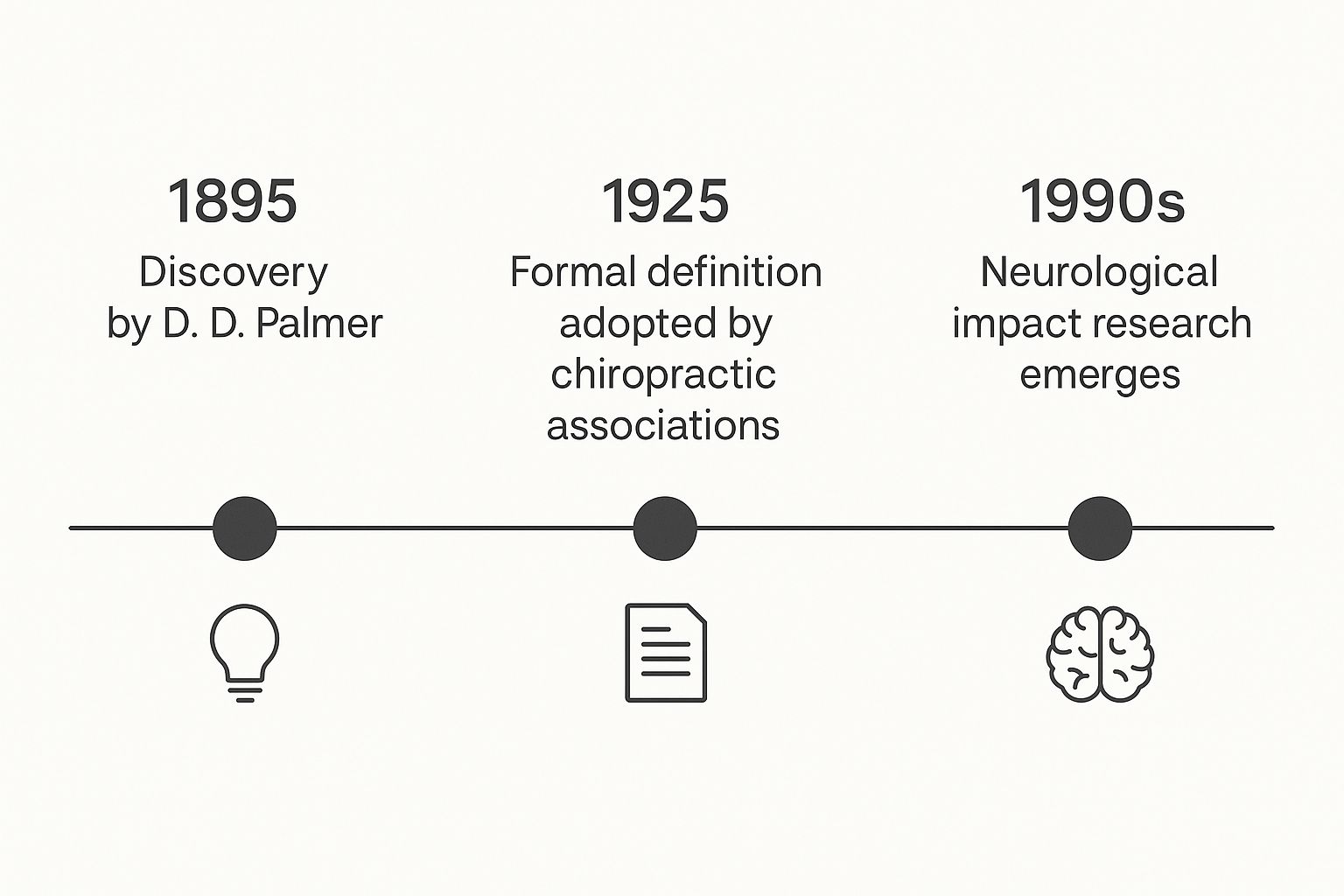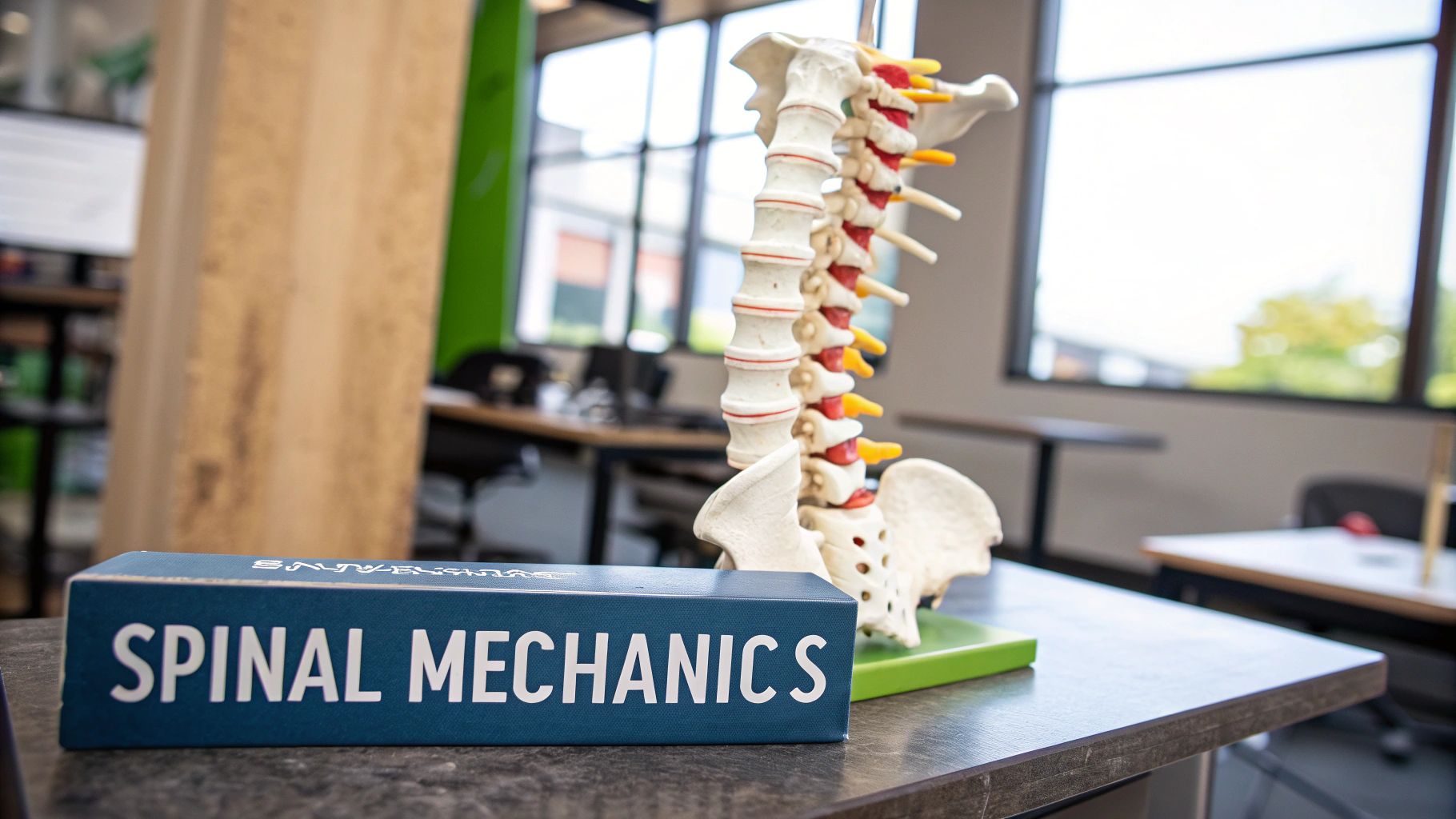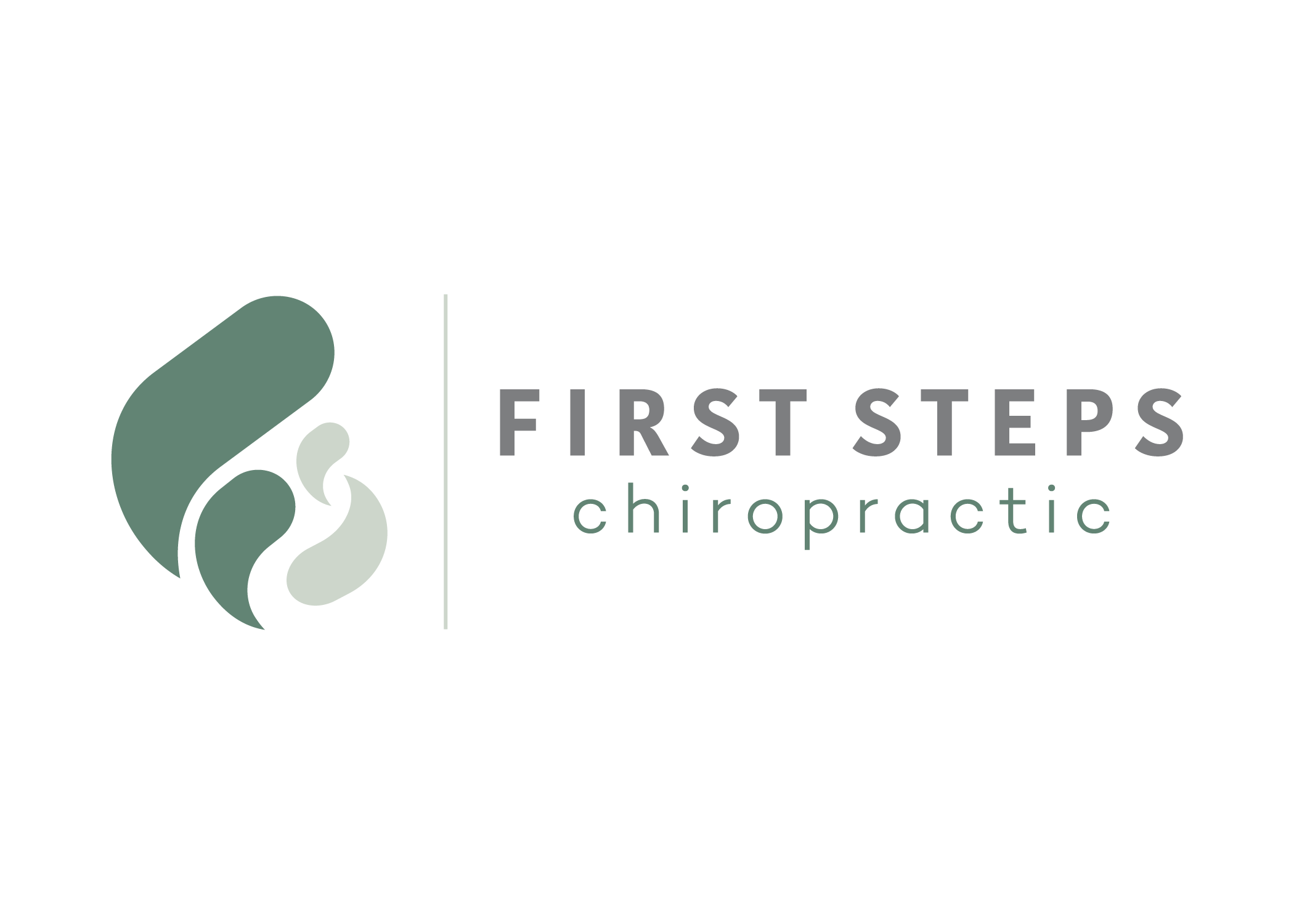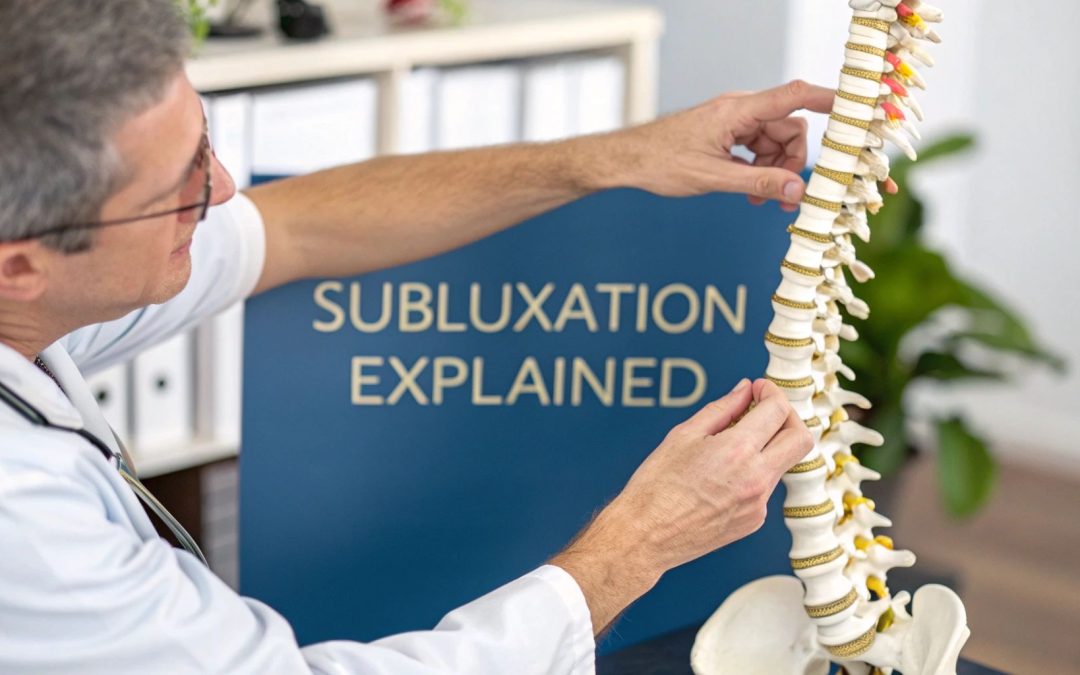When you hear the word "subluxation" in our office, what does that actually mean? For most people, it’s a new term, and it’s central to everything we do.
In chiropractic, a subluxation isn't just about a "bone out of place." It's a much more nuanced concept. Think of it as a specific, subtle misalignment in your spine that creates interference in your nervous system—kind of like a dimmer switch turning down the power on a lightbulb. The connection is still there, but it's not at 100%.
This interference disrupts the vital communication highway between your brain and your body, which can affect your health in ways you might not expect.
What Is The Chiropractic Definition Of Subluxation

To really get what we're talking about, it’s helpful to understand how our definition of subluxation differs from the one used in conventional medicine. This is a point of confusion for many people, so let’s clear it up.
In a medical setting, a subluxation is a partial dislocation of a joint—a pretty significant structural issue you can often see on an X-ray. It’s an anatomical problem, like a door that's come slightly off its hinges.
The chiropractic view, however, is all about function. We're looking at how a joint is moving and how that movement (or lack thereof) is impacting the nervous system. A chiropractic subluxation creates nerve interference, and that’s the real issue we're focused on correcting.
A Functional Problem, Not Just A Structural One
This isn't just about where the bone sits; it's about how it's working. That's a huge distinction. This functional model explains why two people can have a similar-looking X-ray but experience completely different symptoms.
This focus on the nervous system's function, or "tone" as the early pioneers of chiropractic called it, has been at the core of the profession for over 128 years. The understanding has evolved from seeing it as a simple bone-on-nerve issue to recognizing it as a complex disruption along the entire spectrum of the nervous system.
A chiropractic subluxation is less about the bone's static position and more about the dynamic interference it creates within the nervous system, impacting the body's ability to heal and regulate itself.
Key Distinctions To Understand
To simplify this, the main takeaway is that medicine sees a structural problem, while chiropractic sees a functional one.
Understanding this difference is the first step to seeing why chiropractic adjustments are so unique. We’re not trying to force a bone back into a specific spot. We're working to restore proper motion to the joint, which in turn clears up that nerve interference.
Chiropractic vs. Medical Subluxation At A Glance
The distinction between the chiropractic and medical definitions of "subluxation" can be confusing, but it's crucial for understanding the goals of care. This table breaks down the core differences in a simple, side-by-side comparison.
| Aspect | Chiropractic Subluxation | Medical Subluxation |
|---|---|---|
| Primary Focus | Functional | Structural |
| Main Issue | Nerve interference and abnormal motion | Partial joint dislocation |
| Cause | Can be from physical, chemical, or emotional stress | Typically from acute trauma or injury |
| Visibility on X-ray | May or may not be visible | Usually clearly visible |
| Goal of Treatment | Restore proper motion and nerve function | Reduce the dislocation and stabilize the joint |
As you can see, while both use the same word, they are describing fundamentally different conditions with different approaches to correction. One is about restoring communication, the other is about fixing a mechanical break.
When we restore proper motion and normalize nerve function, we allow the body's innate intelligence to take over. That's the foundation of how chiropractic care influences the nervous system and promotes true, lasting well-being.
The Evolution Of The Subluxation Concept
The way chiropractors talk about subluxation today didn't just pop up out of nowhere. It's actually the result of more than a century of hands-on clinical work, dedicated research, and plenty of passionate debate within the profession. Taking a quick look at this journey really helps to understand why the modern focus is so squarely on nerve function and your overall health.
It all started with the founders of chiropractic, D.D. and B.J. Palmer. Their first model was all about structure. They saw a subluxation as a physical misalignment—basically, a vertebra that had shifted slightly out of place, putting direct pressure on a spinal nerve and blocking the flow of the body's vital nerve energy. It was a simple, powerful "bone-on-nerve" idea that was easy for people to grasp.
From Static Bones To Dynamic Motion
But it didn’t take long for other chiropractic pioneers to start building on that foundation. As early as 1906, forward-thinkers like Smith Langworthy and Oakley Smith suggested a more dynamic view. They argued that the real issue wasn't just the bone's position but its abnormal motion.
This was a big deal. It sparked a key debate that shaped the profession: was a subluxation about a bone being out of place, or was it about a joint not moving the way it was designed to?
While this motion-centered view started gaining ground, especially in Europe, chiropractors in North America began using the term "fixation." This described a joint that was essentially stuck or locked up, unable to move through its full, healthy range. If you want to dive deeper, you can explore the historical perspectives of these early definitions to see how the ideas evolved over time.
This timeline gives a great snapshot of the key moments that shaped the chiropractic definition of subluxation.

You can see a clear shift from a simple mechanical idea to a much more sophisticated, science-backed neurological concept.
The Modern Neuro-Functional Model
This whole journey led us directly to where we are today with the neuro-functional model. Research eventually revealed that the effects of a subluxation are far more complex than just a pinched nerve. What we now know is that a stuck or improperly moving joint sends a constant flood of distorted information up to the brain.
Think of it like having static on a phone line. You can still hear the person on the other end, but the message is garbled and hard to understand. This "noisy" sensory input from the body can cause the brain to misinterpret what's really going on, leading it to send out faulty commands that affect everything from your muscles and organs to your overall function.
Today, the subluxation definition chiropractic professionals use points to a neuro-spinal dysfunction. It's a communication breakdown—a disruption in the critical conversation between your brain and your body that holds you back from functioning at 100%.
This evolution from a "bone-out-of-place" idea to a refined neurological one shows how the chiropractic profession has grown right alongside science. It highlights a crucial point: correcting a subluxation isn’t just about moving a bone back into place. It’s about rebooting the entire nervous system to restore clear communication and unlock health from the inside out.
How Chiropractors Identify Subluxations

Finding a subluxation isn't about just poking around for a sore spot. It's a detailed investigation. Since the subluxation definition chiropractic is all about nerve interference, we use a multi-faceted approach to pinpoint exactly where the communication breakdown is happening between your brain and your body. This systematic process ensures we’re basing our care on objective, repeatable findings.
Think of a comprehensive chiropractic exam as skilled detective work. We’re gathering clues from different systems in your body to build a complete picture of your spinal and neurological health. After a thorough health history, we move into hands-on assessments and advanced technology to see what’s really going on.
Hands-On Assessment and Functional Tests
The cornerstone of any chiropractic exam is palpation. This is far more than simply pressing on your back; it’s a highly skilled art where we feel for subtle, important changes along your spine.
- Static Palpation: While you’re sitting or lying still, we gently feel for tenderness, swelling, tight muscles, or even slight temperature changes. These are often the first signs of underlying inflammation and nerve irritation.
- Motion Palpation: Here, we carefully move your spine and joints through their natural ranges of motion. We’re feeling for any joints that feel "stuck" or fixated—a classic sign of a subluxation.
Beyond what we can feel, a series of functional tests give us even more objective data. This often includes a postural analysis to spot imbalances and range of motion tests to measure how freely your neck and back are actually moving. We also perform specific orthopedic and neurological checks, like reflex and muscle strength tests, to see how well your nervous system is controlling your body.
A chiropractic exam isn’t just about finding what hurts. It’s about discovering where your body is losing its ability to function, adapt, and heal properly because of neurological interference.
Advanced Neurological Scans
While a hands-on exam is absolutely essential, modern technology lets us see things our hands can't. These advanced tools give us a direct window into how your nervous system is functioning, measuring the very interference we aim to correct. This provides an invaluable baseline so we can track your progress with incredible precision.
Two of the key technologies we rely on are:
- Thermography: This incredible tool measures temperature differences along your spine. When temperatures are uneven, it can point to inflammation and autonomic nerve dysfunction, which are directly linked to subluxations.
- Surface EMG (sEMG): This scan measures the electrical activity in the muscles that support your spine. If we see imbalanced or overworked muscles, it’s a clear sign that the nerves are firing improperly and creating patterns of chronic tension.
These scans are completely non-invasive, safe for every member of the family, and give us a clear, visual map of your spinal health. By combining these findings, we can identify the exact location and severity of subluxations. To see this technology in action, you can learn more about how Insight Scans map the nervous system and guide the specific care we provide.
Common Signs And Symptoms Of A Subluxation
So, how can you tell if you have a subluxation? Because the real issue is nerve interference, the signs can pop up all over the body, and they don't always involve pain. A subluxation is a lot like a tripped circuit breaker in your house—it’s not just one light that goes out. Sometimes it affects an entire room or even multiple systems at once.
The symptoms usually fall into three main buckets: direct pain signals, functional problems, and the more subtle, indirect signs of nerve interference. Learning to recognize these can help you connect the dots between your own health concerns and a potential underlying issue in your spine.
Direct Pain and Discomfort
This is the most obvious category and the one that usually sends people looking for help. When a spinal joint gets stuck and starts irritating a nearby nerve, your body’s alarm system—pain—starts ringing.
- Headaches and Migraines: A subluxation in your upper neck, specifically the C1 or C2 vertebrae, is a classic culprit behind tension headaches that feel like a tight band wrapped around your head. It can also be a major trigger for those debilitating migraines.
- Neck and Back Pain: This can feel like anything from a dull, constant ache to a sharp, stabbing pain. You might feel it in one specific spot, or it could radiate across your shoulders or down your back.
- Sciatica: If a subluxation in your lower back is pressing on the sciatic nerve, you’ll likely feel that signature pain, numbness, or tingling that travels all the way down your leg.
Functional and Mobility Problems
Pain aside, a subluxation directly messes with how your body moves and functions. This loss of normal motion is a core piece of the subluxation definition chiropractic professionals use. You might not be in active pain, but you'll notice things just don’t feel right.
The big takeaway here is that a lack of pain doesn't mean there's no problem. Functional issues like stiffness are often the first warning signs that your nervous system is being compromised by a subluxation.
These functional symptoms can start out small but tend to get worse if they aren't addressed.
- Stiffness or Reduced Range of Motion: Maybe you can’t turn your head as far to one side anymore, or you feel a little "catch" in your back when you bend over.
- Poor Balance or Dizziness: The nerves in your neck are critical for sending your brain information about where your body is in space. When there’s interference, it can lead to feeling unsteady on your feet or even vertigo.
- Muscle Weakness or Imbalances: Ever notice one arm feels weaker than the other? Or that certain muscles feel constantly tight, no matter how much you stretch? That could be a sign.
Indirect Signs of Nerve Interference
This is where the connection gets a little less obvious, but it’s incredibly important. Your nervous system is the master coordinator for every single function in your body, from your digestion to your sleep cycle. When those nerve signals get garbled, all sorts of seemingly unrelated health issues can show up.
Think of it like this: a subluxation in the upper part of your spine can affect the nerves that influence your sinuses, while one in your lower back can impact digestive organs. This is exactly why people under chiropractic care often report improvements in areas they never expected. Common examples include things like insomnia, allergies, digestive issues, chronic fatigue, and even high blood pressure. These symptoms can be your body’s way of telling you its internal communication network is struggling.
Modern Techniques For Correcting Subluxations

Once we've pinpointed a subluxation, the next step is a specific, gentle correction. This is where the real art and science of a chiropractic adjustment come into play. It’s so much more than a generic "back crack." Think of it as a precise signal sent to the nervous system, designed to restore proper motion to a stuck joint and clear up any interference.
Every single person’s body and nervous system is unique, so there’s no such thing as a one-size-fits-all approach. A professional chiropractor draws from a variety of techniques, carefully choosing the right one for each patient’s specific needs, age, and comfort level. But the goal is always the same: improve how the spine functions and strengthen that all-important brain-body connection.
The Spectrum Of Chiropractic Adjustments
Chiropractic techniques can be broken down into different categories, from traditional manual adjustments to newer instrument-assisted methods. Each one has its own unique benefits and is used for different situations.
One of the most widely recognized approaches is the Diversified technique. This is often what people picture when they think of a chiropractor. It involves a high-velocity, low-amplitude (HVLA) thrust—basically a quick, controlled push that helps get a fixated joint moving again. This is the technique that can produce an audible "popping" sound (called a cavitation), which is just the release of gas from the joint fluid. Nothing is actually cracking!
However, many modern techniques are designed to be incredibly gentle, without any twisting or popping at all. These methods are perfect for infants, children, pregnant women, and really anyone who prefers a lighter touch.
The core principle behind any adjustment is precision. It's not about using brute force, but about applying a specific input into the nervous system at the right place and time to help the body correct itself.
Gentle and Neurologically-Focused Techniques
In our office, we specialize in methods that are both gentle and neurologically specific. This ensures the adjustment is not only comfortable but also incredibly effective.
-
Torque Release Technique (TRT): This is one of the primary methods we use. TRT utilizes a specialized handheld instrument called the Integrator to deliver a very precise and gentle impulse into the spine. It's designed to correct subluxations with minimal force, making it exceptionally safe for patients of all ages, from newborns to seniors.
-
Webster Technique: This is a specific chiropractic analysis and adjustment used for pregnant women. The main goal is to reduce subluxation in the sacrum and improve the function of the sacroiliac joints. By restoring proper biomechanics in the pelvis, it helps create the best possible environment for the baby’s development and can contribute to a smoother labor and delivery.
These advanced methods go far beyond a purely mechanical view of the spine. They directly address the neurological component of the subluxation definition chiropractic professionals use. The focus is on improving the communication lines between the brain and body, which is a key part of how functional neurology chiropractic care supports overall health and well-being. By choosing the right technique for each individual, we can provide targeted care that helps unlock the body's innate ability to heal itself.
The Scientific Conversation Around Subluxation
The idea of a subluxation has definitely sparked its fair share of discussion, both within the chiropractic world and in the broader healthcare community. But this dialogue isn't a weakness—it's actually a sign of a profession that’s committed to growing and refining its core principles through solid scientific research. As chiropractic evolved from its philosophical roots into a modern, evidence-based practice, the need to scientifically explore its foundational concepts became crucial.
This shift really picked up steam in the last few decades. By the 1990s, the conversation began to change in a big way when chiropractic colleges in the U.S. started receiving federal funding to study the effects of spinal adjustments. This was a massive step forward. It brought the chiropractic definition of subluxation out of the clinic and into the research lab, allowing for formal studies on its role in health and its real-world impact on the nervous system. You can read the full research on how this period shaped chiropractic's professional standing on NCBI.
From Controversy to Clarity
Historically, the term "subluxation" has been a sticking point with other medical fields. A lot of this came down to different ways of looking at the body—the chiropractic functional model versus the medical structural model. But today, ongoing research is starting to bridge that gap.
Modern studies are digging deep into the neurophysiological effects of spinal dysfunction. In other words, what’s actually happening to the brain and nervous system when a spinal segment isn't moving the way it should? Researchers are now able to measure real-time changes in things like:
- Proprioception (your brain's internal map of where your body is in space)
- Sensorimotor integration (how your brain takes in sensory information and coordinates movement in response)
- Autonomic nervous system function (the system that runs all your background processes, like your heart rate, digestion, and stress response)
This scientific exploration is shifting the focus from simply asking "where is the bone?" to a much more important question: "how is the nervous system behaving as a result of the spinal issue?" This lines up perfectly with the modern, neuro-tonal approach to chiropractic care that we use.
A Profession Grounded in Evidence
This deep commitment to scientific validation builds trust and makes the entire process more transparent. It acknowledges the historical debates while showing that chiropractic is a dynamic, evolving healthcare discipline—not one that's stuck in the past. This ongoing research ensures that the way we identify and correct subluxations is backed by a constantly growing body of evidence.
This is also why so many patients under chiropractic care report improvements in areas that go far beyond just neck or back pain. By scientifically exploring the profound link between the spine's function and the health of the nervous system, the profession continues to solidify its vital role in modern wellness.
Frequently Asked Questions About Subluxations
Even after learning what a subluxation is, it's natural to have a few more questions pop up. Let's tackle some of the most common ones we hear from families to clear up any confusion.
Can a Subluxation Be Seen on an X-ray?
This is a great question, and the answer is both yes and no. While an X-ray can definitely show a bone that's out of position or a spine that's misaligned, it can't capture the whole story of a chiropractic subluxation.
Remember, a subluxation is more than just a misplaced bone; it's a functional problem involving nerve interference and a lack of proper motion. Think of it like a photograph of a car—you can see if it's dented, but you can't tell if the engine is running smoothly. We use X-rays as one important piece of the diagnostic puzzle, combining them with physical exams and advanced neurological scans to get a complete picture.
Is a Chiropractic Adjustment Just Cracking My Back?
Not at all. The goal of a chiropractic adjustment is to apply a very specific, controlled force to a targeted joint to restore its proper function and, most importantly, clear out any nerve interference.
When someone "cracks" their own back, it's a non-specific movement that often just moves the joints that are already mobile, which can sometimes lead to instability. It completely lacks the diagnostic precision and therapeutic intent of a professional adjustment from a trained chiropractor.
That "popping" sound you might hear isn't your bones cracking! It’s simply the release of gas from the joint fluid, similar to opening a can of soda. In fact, many of the gentle, neurologically-focused techniques we use produce no sound at all.
Do I Need to Be in Pain to Have a Subluxation?
Absolutely not. In fact, pain is often the very last symptom to show up. It's a common misconception that if you're not in pain, everything must be fine.
A surprisingly small part of your nervous system—only about 10%—is dedicated to sensing pain. This means a subluxation can exist for a long time, silently affecting your mobility, energy levels, or even organ function without you ever feeling a hint of discomfort. Chiropractic care is all about correcting this underlying dysfunction before it becomes a painful problem.
At First Steps Chiropractic, we specialize in identifying and correcting the root cause of health challenges through gentle, neurologically-focused care. Schedule your complimentary consultation to see how we can help your family thrive by visiting https://firststepschiropractic.com.

